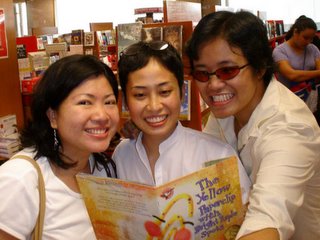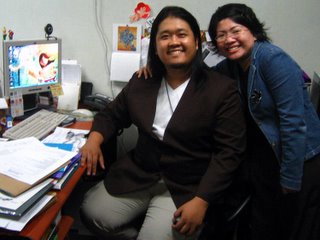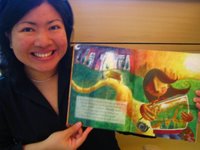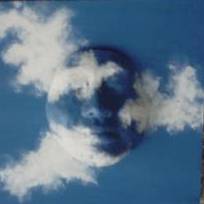My boss invited me as the guest speaker for their regular meeting of the Rotary Club of Makati North at The Conservatory in The Peninsula Manila Hotel. Thank you for a great opportunity, VLM! Here's the transcript of my 15-minutes-of-fame:A STORYTELLING SESSION
Ladies and gentlemen, thank you for inviting me to join you this afternoon. In the next 20 minutes, we will have a storytelling session of
The Yellow Paperclip with Bright Purple Spots and other equally colorful stories. I will tell you stories and also ask you questions along the way.
First question. May I see a show of hands: Who among you have children below the age of ten? Keep your hands up. Who among you have grandchildren? (Or, let me rephrase that question: who among you is married to a grandmother?) Please keep your hands up if you answer yes to my third and last question: Who among you read to your children or your grandchildren?
It must be difficult to compete with the Cartoon Network, cellphones, 3-D computer games, surfing the Internet, or iPods, but reading is not just another hobby or pastime. Why should we read to children? Mary Ellen Chase, an American scholar, teacher and writer, said: “There is no substitute for books in the life of a child.” We are what we read. We are a part of everything that we have read. But in my case, allow me to add to that: we are, or we become, what we read and write.
 Reading
Reading and writing have always been a part of who I am. While most 7-year-olds took ballet or piano lessons, I was a nerdy kid and chose speed reading and creative writing classes. I started my first journal in second grade and have kept a journal since. My Dear Diary and Nancy Drew were my closest friends as I grew up. My love for reading and writing continued in middle school when I discovered Shakespeare, wrote for the school paper, and enjoyed the 15-minute-a-day journal-writing activity for my English class. I fell in love with Tolstoy’s Levin and Miller’s Biff Loman in high school; it got so bad that I would sometimes quote lines from Russian novels in conversations with friends. I re-read Shakespeare (and played Moth in our production of
A Midsummer Night’s Dream) and continued to write: I wrote on the school bus, under the trees, and in coffee shops; I wrote for school assignments, for friends, for myself, for fun. Armed with a flashlight and a pen under my blanket, I would write past my bedtime, furiously and secretly, about the angst and dreams of a 16-year-old. In college, I drank from Walden’s Pond, woke up with a jolt after reading Fr. De Mello’s
The Way to Love, and, admittedly, enjoyed writing lengthy papers on Walt Whitman and Hannah Arendt. After getting teary-eyed with Shel Silverstein’s stories,
The Missing Piece and
The Missing Piece Meets the Big O, rediscovering Dr. Seuss, and seeing myself in Yellow in
Hope for the Flowers, I decided to sign up for a class in Writing and Illustrating for Children. The class only confirmed my growing interest and appreciation for children’s literature.

We read because books help shape who we are. What books did you read? What books do your children or grandchildren read? But let me ask another question: what’s so special about a children’s story? I got an anonymous quote off Google: “Good children's literature appeals not only to the child in the adult, but to the adult in the child.” I like stories with multiple meanings for both kids and grown-ups. A story about butterflies speaks of hope and second chances. A story with very simple penciled cartoons captures our desire to belong and to be loved by another. A wacky story with fuzzy creatures in a pop-up book illustrates life’s exciting adventures. Children’s literature presents life in a seemingly simple way; but upon a closer read, it is full of meaning and wonder and learning. The legendary
Dr. Seuss says it best: “The more that you read, the more things you will know. The more that you learn, the more places you'll go.”
“Write, Nikki, write,” a friend of mine urged, as she emailed me the details of the PBBY-Salanga Prize. To publish a book was the first on my Top Three Things To Do Before I Die List and I had always dreamed of writing my own children’s story, a cross between fiction and modern-day fable, a story for both the child in adults and the adults in children. After several brainstorming sessions with different groups of people and many nights in front of a blank computer screen, I came up with a story I submitted on the deadliest deadline date, October 1, 2004.
One year later—or let’s say, one year, one gold medal, one book fair, one book launch, two interviews, several storytelling sessions, and X number of books sold LATER—I’m happy to be here to share with you the story behind my story.
You must be wondering: why a story about a paperclip? It started out as a little game my college boyfriend and I used to play. We would see paperclips frequently in the strangest places: lost on the bench, along the sidewalk, between the stones of the Quad, on the library steps. We would wonder where they had been and how they got there. Before the October deadline, I brainstormed with
Becca, my colleague’s 10-year-old daughter, and asked for her opinion about the different stories I had in my head. She thought stories about fish and Christmas were boring. When I asked her where she last saw a paperclip and where it could have been, her eyes lit up with curiosity. In between giggles, we traced the paperclip’s adventures as it wove through the lives of various people and situations; the light in her eyes told me I had a good story. But there are many more untold stories behind
The Yellow Paperclip with Bright Purple Spots. When you read my story, I hope you also read between the lines and between the pages.
First, it’s a story about being different yet making a difference. We’ve all felt a little out-of-place. We’ve all felt lost and unimportant. I know I have. A paperclip is something easily ignored and essentially insignificant; but because it has traveled to different places, learned new things, made friends, and accepted its bright purple spots, it has developed a sense of self and purpose.

Secondly, it’s a story that cuts across cultures and time zones. The humble paperclip is recognized on any continent. What started out as a Norwegian invention in 1899 has been used as a symbol of unity against the Nazis, a gift of hope and hugs during the first Gulf War, a trading gimmick in
Montreal, and as cool
giant sculptures around
Ayala Museum. It has 922,000 entries on Google and is used in many logos and design elements. Third graders in
Xavier School in
Greenhills and in a public school in
Pittsburgh enjoyed the story. I was told my story wasn’t too Filipino; that was deliberate on my part. I wanted my story to bridge gaps and make the world an even smaller place. Wish me and May Ann luck as we wait for the results of the
International Reading Association’s annual children’s story award. We submitted our book for an award for first time authors and illustrators; we should find out before the year ends.
Lastly, it’s a story about being amazed at the ordinary and mundane things in life. Most people couldn’t care less about paperclips; hopefully, after reading my story, you and your children or grandchildren will never see a paperclip in the same way. Ever. I gave out colored paperclips at the end of my storytelling sessions at the Manila International Book Fair, at Powerbooks and at
Xavier School; with their wide-eyed smiles and excited shrieks of “Me! Me! Me! I want one!” you’d think these kids have never seen a paperclip before! It was as if they were seeing a paperclip for the very first time. I loved it. Wouldn’t the world be a much happier place if we all learned to relish every moment and every little thing as if for the first time?
The Yellow Paperclip with Bright Purple Spots is part fable, part fiction (but with real-life characters) and part autobiography. It’s a story that links other colorful stories, different people, places, and experiences. I still see paperclips—at least two a day—not on my desk at the office but in strange places. I hope you do too. The next time you see a paperclip, stop, smile, think of where it has been, and begin a new adventure.
 The Adarna Book Carnival traveled to National Bookstore in Glorietta where May Ann and I joined the storytelling and book signing sessions. We got a handful of kids listening to Kuya Jay tell the story. One of them even won a copy of the book by retelling the story! May Ann and I signed a lot of books, both from the kids and also from each others' purchases! Hee-hee.
The Adarna Book Carnival traveled to National Bookstore in Glorietta where May Ann and I joined the storytelling and book signing sessions. We got a handful of kids listening to Kuya Jay tell the story. One of them even won a copy of the book by retelling the story! May Ann and I signed a lot of books, both from the kids and also from each others' purchases! Hee-hee.








